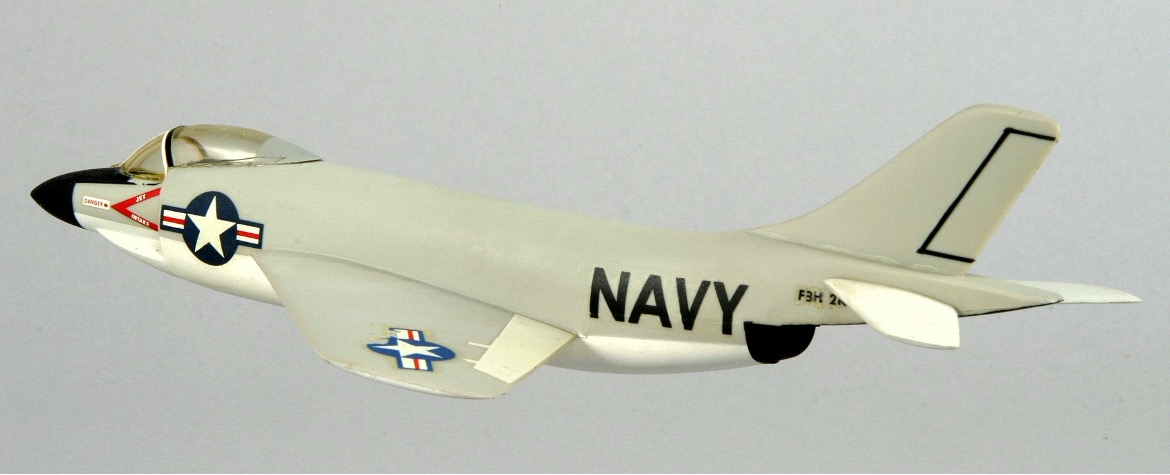USN NASWF McDonnell F3H Demon

McDonnell Company
1/72
03/09/1966
historical significance
First Albuquerque Visit: 1955
Additional Information:
The McDonnell F3H Demon was a subsonic carrier-based jet fighter. The Demon was the first swept wing jet fighter and the only single-engine carrier-based fighter the company produced. The Demon was developed during the late 1940s and early 1950s to fulfill a United States Navy requirement for a high-performance swept wing naval fighter to succeed the F2H Banshee. The Demon was originally designed to be powered by the Westinghouse J40 turbojet engine, which suffered low thrust output and poor reliability, and was ultimately abandoned in 1955. The aircraft was then redesigned to accept the Allison J71 engine.
The Demon entered operational service on 7 March 1956 and although the aircraft had insufficient power for supersonic performance and insufficient endurance for its intended general-purpose role, it complemented day fighters such as the Vought F8U Crusader and Grumman F11F Tiger as an all-weather, missile-armed interceptor. The Demon was withdrawn from service in 1964.
Albuquerque’s Kirtland Field was designated Kirtland Air Force Base in 1947, and the Armed Forces Special Weapons Project (AFSWP) operated on Sandia Base. When the United States Air Force established the Air Force Special Weapons Command at Kirtland Air Force Base in 1949, the United States Navy formed a detachment to investigate nuclear capabilities for naval aircraft and assist the AFSWP with naval equipment for demonstrations and training. The Naval Weapons Evaluation Facility (NWEF) operated through the Cold War investigating aircraft-weapon interfaces to provide United States Navy aircraft with nuclear weapons delivery capability.
In 1952 this detachment was designated the Naval Air Special Weapons Facility (NASWF) to conduct special weapons tests on the White Sands Missile Range and Tonopah Test Range in coordination with the United States Atomic Energy Commission. In March of 1961, the NASWF was re-designated the Naval Weapons Evaluation Facility (NWEF) and its mission was expanded to include safety studies on nuclear weapons. The aircraft used for NWEF testing were decorated with the NWEF thunderbird symbol and the NWEF detachment became known as the Rio Grande Navy by its sailors and civilians.
In 1992, with the consolidation of many naval activities and the drawdown of the U.S. defense budget, NWEF became part of the large, multisite Naval Air Warfare Center Weapons Division in China Lake. In 1993 the NWEF was decommissioned and became the first nuclear-weapons-related facility in the Free World to be shut down. As NWEF closed, it transferred some of its remaining people and functions to the China Lake site.
The Naval Air Special Weapons Facility at Kirtland Air Force Base performed the special weapons suitability tests on the Demon beginning in 1955 at the White Sands Missile Range (WSMR). The aircraft that were tested were Bu No. 133561 and 136990.
A Demon that was assigned to the Naval Air Special Weapons Facility at Kirtland AFB beginning in the late 1950’s is shown in the photos below.
